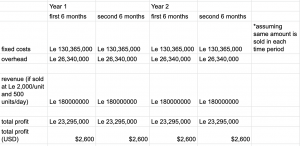1. Funding Sources
Design Phase:
A) ASPEN Nestlé Health Science Enteral Nutrition Research Grant https://www.nutritioncare.org/Research/ARRF/Nestlé_Health_Science_Enteral_Nutrition_Research_Grant/
The ASPEN Rhoda’s Research Foundation this year introduced a new grant opportunity, the Nestlé Health Science Enteral Nutrition Research Grant. The focus of this grant is to address nutrient intake in the critically ill. This would fit as an option for our malnutrition product because it supports projects trying to address clinical problems due to nutrition. The budget of the grant is up to $50,000 for a year of research, and this money would help us advance our product development by funding ingredients, supplements, cooking supplies, shelf life testing, and more.
B) ICATCH GRANT https://www.aap.org/en-us/about-the-aap/Sections/Section-on-International-Child-Health/Pages/ICATCH-Grants.aspx
The ICATCH grant is a possible source of funding for our malnutrition product because they support projects that are developing a product that improves the lives of children in low-income countries. The grant is for a total of $6,000 over the course of 3 years and can be used for the development and implementation of the product into the country. This year specifically, the applications focusing on infant health are being prioritized over adolescents. This money will go towards acquiring necessary supplies such as micronutrient supplements, ingredients for our product, and cooking supplies.
Dissemination Phase:
A) Venturewell DEBUT grant https://venturewell.org/debut/
The National Institute of Biomedical Imaging and Bioengineering (NIBIB) and VentureWell are funding the DEBUT (Design by Biomedical Undergraduate Teams) challenge, which is a grant application for undergraduate students working on innovative solutions to unmet health and clinical problems. This fits into our project since we are developing solutions to address malnutrition in children in developing countries. Teams of students submit proposals to this challenge and can be awarded up to $20,000 in prizes for strong applicants. This money would help in the dissemination part of our project by recognizing design achievements, and then helping fund marketing and economic feasibility to advance the products.
B) The Izumi foundation http://izumi.org/funding-grants/recent-grants-awarded/
The Izumi foundation is a great opportunity to receive funding for our venture project. The foundation is dedicated to supporting projects that create lasting solutions to critical problems in developing countries, such as malnutrition. In the past, projects have been funded for anywhere from $50,000 to $200,000. We will write a proposal for funding that will be used to train and pay the initial workers for our venture. This would be a funding source that we would apply for in the future after we have finalized our products and determined that the product would be popular in Sierra Leone.
2. Income Statement after 2 years
In order to create an income statement for our products we evaluated the cost of goods sold (COGS), overhead costs, profit, and revenue. At this point, we are still somewhat unsure of exactly how our product will be manufactured because we have a few different recipes and are unsure of what equipment we will need. One possibility is that we rent our own manufacturing space, and another is that we rent space or facilities in a restaurant that is already operating in Sierra Leone. We performed the income statement for
For COGS, we made a few assumptions. First, the population of Makeni is around 125,000. https://www.statistics.sl/images/StatisticsSL/Documents/final-results_-2015_population_and_housing_census.pdf Based on census data, we estimated that the population includes around 5,000 children below the age of 2 https://sierraleone.unfpa.org/sites/default/files/pub-pdf/Population%20structure%20Report_1.pdf. If 75% of these children consume our product 3x per day, we need to make around 11,250 units per day. In early stages, we will assume that we are only making around 500 units per day. The quantities are slightly inaccurate because they are they quantities we need in order to make around 1/2 cup of our pudding which is slightly more than the actual serving size of the unit. So, these costs are actually overestimates. With that being said, we did not include general kitchen utensils and equipment (tables, trays, other packaging materials) that may be necessary. The information for COGS is shown below (assuming 500 units per day).
Overhead costs that we will definitely need to consider are electricity and rent. It will also be useful to have a supervisor that can oversee how our product is selling and how children and families like our product.
With this information, we were able to calculate our projections every six months. We assumed that we would produce 500 units/day for the whole two years, but ideally, we will have the resources to produce more as time goes on. For example, if we produced/sold 1,000 units per day in Year 2, we would have a greater profit in Year 2.





